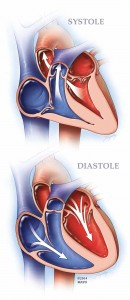-
Weekend Wellness: Blood pressure – both numbers are important to overall health
 DEAR MAYO CLINIC: I have a high systolic (top number) blood pressure, but my diastolic (bottom number) is normal. What does this mean? Is it considered high blood pressure? Do I need any treatment?
DEAR MAYO CLINIC: I have a high systolic (top number) blood pressure, but my diastolic (bottom number) is normal. What does this mean? Is it considered high blood pressure? Do I need any treatment?
ANSWER: When measuring blood pressure, both numbers are important to your overall health. If your systolic blood pressure is high, even if your diastolic number is normal, it could raise your risk for a variety of health concerns. The situation does need to be addressed. Blood pressure medication can be helpful. In some cases, though, lifestyle changes may be the only treatment necessary to lower systolic blood pressure to a healthier level.
Blood pressure is a measure of the pressure in your arteries as your heart pumps. Testing your blood pressure is an important way for your doctor to monitor your general health. A blood pressure reading, given in millimeters of mercury (mmHg), has two numbers. The first, or top, number measures the pressure in your arteries when your heart beats. That is your systolic pressure. The second, or bottom, number measures the pressure in your arteries between beats. That’s your diastolic pressure.
Historically, doctors used to care more about the diastolic blood pressure than the systolic blood pressure. They believed the body could tolerate occasional increases in systolic blood pressure, but consistently high diastolic pressure could lead to health problems. However, more contemporary research has shown that both systolic and diastolic blood pressure need to be consistently within the normal range to lower the health risks associated with high blood pressure.
The type of high blood pressure you describe, known as isolated high systolic blood pressure, is often seen in older adults. It is most common in people whose arteries have lost their elasticity due to aging or diabetes. This condition is called hardening of the arteries. Without treatment, high systolic blood pressure can raise your risk of death, stroke, heart disease and kidney disease.
An ideal systolic blood pressure is considered to be 100 to 120 mmHg. So any systolic blood pressure over 120 mmHg could be considered high. In people younger than 60, however, doctors usually only recommend treatment with medication when systolic blood pressure is higher than 140 mmHg. For those older than 60, treatment with medication typically is recommended when the systolic reading is higher than 150 mmHg.
A variety of lifestyle changes can help lower blood pressure. Doctors often recommend a diet low in sodium, or salt. The exact sodium level you should aim for depends on your age and overall health. Focus on fruits, vegetables, whole grains and low-fat dairy foods in your diet. Limit fats and alcohol. Ask your doctor about a diet that is right for you.
Regular physical activity also can help lower your blood pressure. Try to get at least 30 minutes of exercise each day. Maintaining a healthy weight can make a difference, too. Blood pressure often goes up as you gain weight. If you are overweight, losing just five to 10 pounds can help bring down your blood pressure.
Finally, it is essential that you do not use tobacco. Smoking speeds up the damage caused by high blood pressure. It injures the walls of the blood vessels, making hardening of the arteries worse. If you smoke, ask your doctor about programs or resources in your area that can help you stop.
Talk to your doctor about how best to manage your high systolic blood pressure. Timely treatment is important to keep your blood pressure under control and to lower the serious health risks that can come with untreated high blood pressure. — Andrew Rule, M.D., Nephrology, Mayo Clinic, Rochester, Minn.
Related Articles







